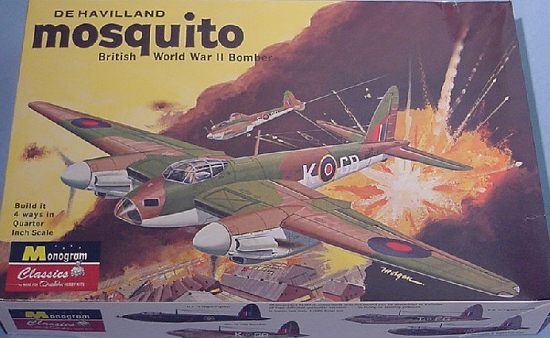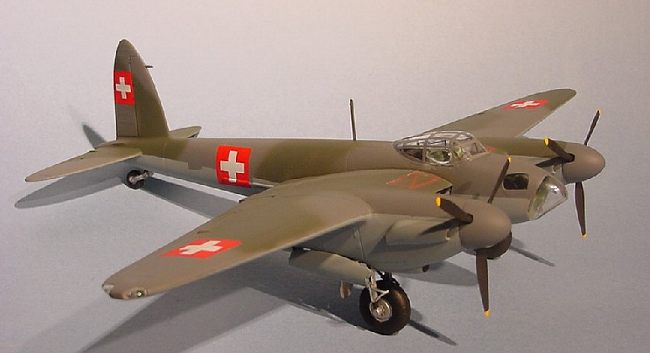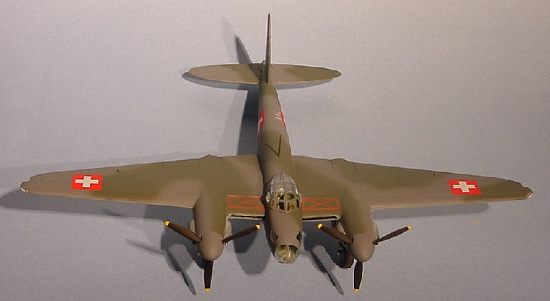
|
KIT: |
Monogram Classics 1/48 Mosquito |
|
KIT # |
85-0129 |
|
PRICE: |
CDN $18.99 |
|
DECALS: |
four aircraft |
|
REVIEWER: |
Olivier Lacombe |
|
NOTES: |
Reissue - 4 variants |

|
HISTORY |
I will not go on and on about the Mosquito. Letís put it simply, the Mosquito was perhaps the best airplane of World War II. Let me explain myself: in its bomber guise, it could drop 4 000 lbs of bombs 1 370 miles from home and return at over 410 mph. Dressed as a fighter, it prowled the skies above Europe and South-East Asia, tangling with whatever came along, whether it be at night or in broad daylight or it could engage ships, trains, or anything that could justify a mighty punch from 4 20mm canons and 4 .303 guns, plus rockets, bombs and various ordnance. It took picture, did weather recon flights, carried important passengers, in short, the Wooden Wonder could anything.
Itís sad that today only one remains in flyable condition (Kermit Weeks owns it, but it seldom flies), but however, one is being rebuilt in British Columbia and some mate in Australia is scratch building one (this is real modeling!)
|
THE KIT |

It may be an oldie, but it sure is a goodie. In a single plastic bag, you get 4 light grey styrene sprues and 2 moulded in black. The black parts comprise the interior, the wheels and the props, to provide youngsters with an Ďalmost realisticí model as I will put it. The panel lines are finely recessed with occasional raised details, such as rivets where needed. This is impressive, since the kit is dated 1966.
The gear doors are moulded shut, but they are easily scribed open. Also note that the flaps and flying controls can also be separated f you wish, the lines are that sharp. You can either build the aircraft clear or solid nosed. To do the later, you have to cut a portion of the forward fuselage just ahead of the wing root, but again, Monogram made a big nice line for that purpose. The exhausts are of the shrouded style with the necessary openings at either ends.
The cockpit is good for a kit of this vintage, with the yoke for the bomber and the stick for the fighter. The dashboards for the respective versions are also included. For the armament, you get the 8 nose guns for the fighter, 8 rockets (for which you have to open holes in the wings) and 2 under wing bombs with their racks. For the NF.II, Monogram provides the aerials for the radar.
 Two different canopy
styles are provided, one with the bulged sides and a straight one. The only
problem I see is that the one with the bulges is made up of two halves, but
careful trimming and aligning should take care of it.
Two different canopy
styles are provided, one with the bulged sides and a straight one. The only
problem I see is that the one with the bulges is made up of two halves, but
careful trimming and aligning should take care of it.
As for ejector marks and sinkholes, the marks are easily filed away and the only holes Iíve found were on the rocketís zero-length rails, also easily fixable.
Since the kit allows you to build 4 different versions, you get six different aircrafts on the decal sheet. The decals themselves are very nice, they are some of the newer ones produced by Revel-Monogram and are easy to use (Iíve had nor problems with other kits). This is what you can build out of the box: one N.F. II for Home Defence, one Mk IV bomber from 105 Squadron, one FB VI fighter bomber from 418 Squadron in Australia, one Mk II night intruder from 23 Squadron, one FB VI fighter bomber from /05 ďZiemi WielkopolskiezĒ Polish Squadron with D-Day stripes and one FB VI fighter bomber from 487 Squadron.
|
CONCLUSIONS |
This is one good bargain. 4 versions, 6 different aircrafts. What more can we ask as a modeller? Letís just hope that the re-issuing trend will continue and give us a B-26, an A-26, a B-29Ö
Review kit courtesy of me and my wallet!
|
REFERENCES |
GREEN, William, Famous Bombers of the Second World War, Doubleday and Company edition, Great Britain, 1969.
If you would like your product reviewed fairly and quickly by a site that has well over 100,000 visitors a month, please contact me or see other details in the Note to Contributors.